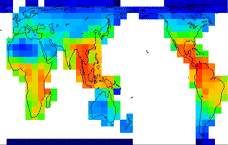Tropical fauna challenge taxonomy because species richness is greater in the tropical than in temperate zones, most tropical species are as yet undescribed, and within-species genetic variation appears to be greater.

Land Animal and Plant Biodiversity World Map
Two recent papers show DNA barcoding aids species identification and discovery in tropical fauna. In January 24, 2006 Proceedings of the National Academy of Sciences USA, Hajibabaei et al examine 4260 specimens representing 521 (71%) of hesperiids (skipper butterflies), sphingids (sphinx moths), and saturniid moths of the of the ACG conservation area in Costa Rica. 510 (98%) of recognized species have distinct barcodes, 11 (2%) have barcodes that overlap with another closely-related species, and 13 recognized species have 2 or more distinct barcode clusters. Associated co-variation in habitat, food plant, and adult and caterpillar morphology indicate these clusters represent cryptic species, a total of 27 new species whose discovery was facilitated by barcoding.
In a similar vein, DNA barcoding revealed cryptic species with unsuspected host-specificity in a genus of presumed generalist tropical parasitoid tachinid flies. Insect parasitoids are a major cause of natural insect mortality and are used as biological control agents. They are thought to represent 8%-25% of all insect species, but understanding species richness and biology is hampered by the very large number of morphologically similar species. A published commentary by Herre emphasizes “…the value of DNA barcoding in uncovering hidden diversity…especially when coupled with traditional taxonomy and a keen appreciation of the fascinating details of basic natural history.”